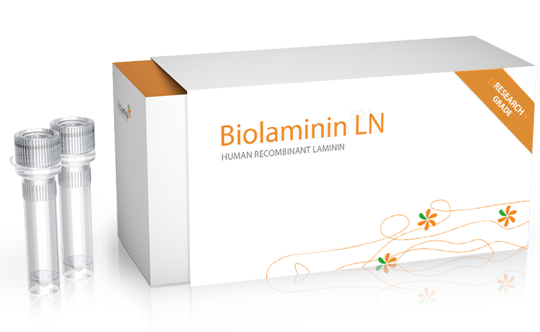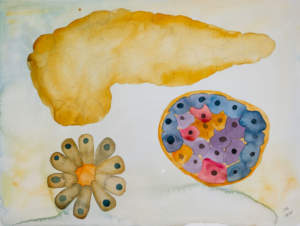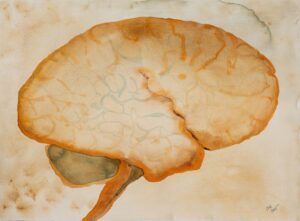Biolaminin 421 LN (LN421)
Full-length human recombinant laminin-421
Biolaminin 421 supports several tissue-specific cell types such as endothelial cells and kidney cells and has been suggested to be important for renal, synaptic, and inflammatory functions.

A biologically relevant culture environment
In the kidney, laminin-421 is produced by mesangial cells and is presumably important for the development and reparation of microvasculature and glomerulogenesis (Abrass, 2010) whereas kidney podocytes mainly bind to laminin 521 via the α3β1 integrin (Sachs and Sonnenberg, 2013). Laminin 421 has also been implicated in renal cell carcinomas (Lohi, 1996; Vainionpää, 2007) and glial brain tumors (Ljubimova, 2001).
In chemical synapses, the laminin-421 isoform is crucial for the correct localization of pre- and post-synaptic specializations. In mice lacking the laminin β2 chain, neuromuscular junctions fail to form active zones in the presynaptic terminal and thereby neurotransmitter release is disrupted (Patton, 2001). Laminin-421 has been shown to assist in the formation and stabilization of active zones by several mechanisms, including voltage-gated Ca2+-channels and integrins containing the α3 subunit (Carlsson, 2003; Cohen, 2000).
Learn more about full-length laminins:
Recommended applications
-

Pancreatic cells
Biorelevant culture of pancreatic cells on Biolaminin substrates The basement membrane formed next to the beta-cells contains alpha-4 and alpha-5 laminin […]View application -

Kidney cells
Biorelevant culture of renal cells on Biolaminin substrates Laminins play an important role in kidney development Both the tubular and […]View application -

Neural cells
Biorelevant culture of neural cells on Biolaminin substrates Laminins are widely expressed in the nervous system and are essential for […]View application
Key features
Coating plates
1. Thaw recombinant laminins slowly at +4°C before use.
2. Dilute the thawed laminin stock solution with 1x DPBS.
3. Add the diluted laminin solution to tissue culture-treated surfaces, aiming for a final coating concentration of 0.5-2 µg/cm². The optimal coating concentration may vary depending on the specific cell line.
4. Seal the plate (e.g., with Parafilm®) to prevent evaporation, and incubate at +2°C to +8°C overnight. For faster coating, incubate at +37°C for 2 hours. Ensure the laminin solution is evenly distributed across the surface. Note that the laminin matrix will become inactivated if allowed to dry.
Important notes
Preparation and handling
- Perform all procedures under sterile conditions using aseptic techniques.
- Minimize exposure of the protein to ambient temperatures.
Storage and stability
Laminin stock solution storage
- Store the frozen laminin stock solution at -20°C to -80°C for long-term stability. Refer to the product-specific Certificate of Analysis (CoA) for detailed shelf-life information.
- Avoid repeated freeze-thaw cycles.
- For long-term storage of thawed stock solution, dispense into working aliquots and store at -30°C to -80°C. Thawed, undiluted Biolaminin stock remains stable for 3 months at +2°C to +8°C.
Coated plate storage
- Store coated plates aseptically at +2°C to +8°C for up to 4 weeks. Do not let the surface dry.
Cell culture setup
- Use appropriate culture media and dissociation reagents to create fully defined, animal component-free protocols.
- Ensure high-quality cells when transferring to the Biolaminin matrix.
- When moving your cells from another feeder-free matrix (e.g., Matrigel), we recommend starting with a smaller well format (e.g., 96-well or 48-well format) and a higher seeding density for the first few passages. This allows the cells to adapt to the laminin matrix before increasing the culture well format and lowering the seeding density.
Troubleshooting Guide
Biolaminin plate coating
Uneven cell spread is often a coating issue and may be caused by:
- Low coating concentration: Ensure the laminin coating concentration is high enough to support even cell growth. Increase the concentration if necessary.
Poor coating coverage or plate drying: Confirm that the entire surface is covered with the laminin coating solution when preparing fresh plates. Avoid drying out the plate, as this will inactivate the laminin. Prolonged time in the incubator or long storage without proper sealing can cause evaporation, leading to localized drying, often in the center of the plate.
Product name
Biolaminin 421 LN
Product code
LN421-02
LN421-0501
Declaration
For research use only
Storage
-20°C to -80°C
Concentration
0.1 mg/ml
Appearance
Clear, colorless, buffered solution with a
pH of 7.2 with 10% glycerol and 0.02% NaN3
Shipping condition
Dry Ice
Protein name
Laminin 421 (Laminin-9)
Classification
Animal origin-free, human recombinant protein
Product application
Culture of endothelial cells, mesangial cells, and maturation of neuromuscular junctions
Size guide
Not sure how much laminin you need? To make it easy, we have created a tool where you can calculate the amount needed for your experiments. Just choose the culture well format and fill in the desired coating concentration to see the amount required.
Please see the coating instructions for concentration and volume guidelines.